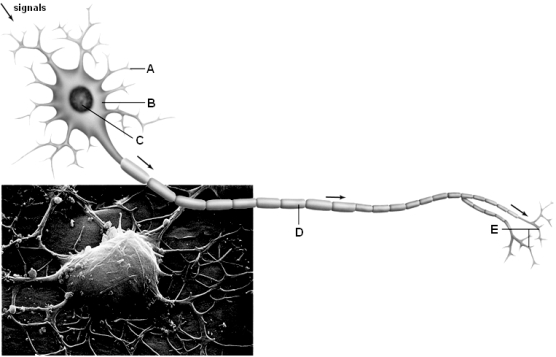A) stimulus, sensory neurons, interneurons, motor neurons, effectors
B) effectors, sensory neurons, interneurons, motor neurons, stimulus
C) sensory neurons, stimulus, interneurons, motor neurons, effectors
D) motor neurons, interneurons, stimulus, sensory neurons, effectors
E) none of these
Correct Answer

verified
Correct Answer
verified
Multiple Choice
An action potential in a neuron begins when
A) a threshold potential is reached.
B) the resting potential is established.
C) gated sodium channels close.
D) when gated potassium channels close.
E) more than one of these occur.
Correct Answer

verified
Correct Answer
verified
Multiple Choice
A person who has had a frontal lobotomy
A) is calmer.
B) has blunted emotions.
C) impaired ability to concentrate.
D) does not behave appropriately.
E) is described by all of these.
Correct Answer

verified
Correct Answer
verified
Multiple Choice
The pleasurable feeling one gets from taking Ecstacy is related to the neurotransmitter,
A) endorphin.
B) acetlycholine.
C) dopamine.
D) serotonin.
E) epinephrine.
Correct Answer

verified
Correct Answer
verified
Multiple Choice
The active ingredient in Ecstacy works by
A) binding to active transporters in brain neuron membranes.
B) blocking the movement of neurotransmitters across synapses
C) binding to neuroreceptors on the ends of neurons
D) stopping signal transmissions down the length of an axon
E) inhibiting the release of neurotransmitters at the synaptic junction
Correct Answer

verified
Correct Answer
verified
Multiple Choice
The white matter differs from gray matter in that
A) white matter is found in the brain, and gray matter is found in the spinal cord.
B) white matter consists of bundles of myelin-sheathed axons, and gray matter consists of cell bodies, dendrites, and neuroglial cell.
C) white matter transmits sensory information, and gray matter transmits motor information.
D) white matter is associated with the sympathetic nervous system, and gray matter is associated with the parasympathetic nervous system.
E) all of these are true.
Correct Answer

verified
Correct Answer
verified
Multiple Choice
This animal has paired nerve cords that connect to a simple brain.This animal is
A) a lobster.
B) a jellyfish.
C) an earthworm.
D) a grasshopper.
E) more than one of these.
Correct Answer

verified
Correct Answer
verified
Multiple Choice
Broca's area of the cerebral cortex
A) governs speech production.
B) is the vision center.
C) is associated with memory storage.
D) is responsible for hearing and smell.
E) is the primary motor area.
Correct Answer

verified
Correct Answer
verified
Multiple Choice
 Use the above figure to answer the following question(s) .
-What is depicted in the above diagram?
Use the above figure to answer the following question(s) .
-What is depicted in the above diagram?
A) a sensory neuron
B) an interneuron
C) a motor neuron
D) a neuroglial cell
E) none of these
Correct Answer

verified
Correct Answer
verified
Essay
Classification.The statements describe the main function of specific structures of the brain.Match the appropriate structure from the list to each function a.cerebellum b.hypothalamus c.cerebrum d.pons e.thalamus -coordinates motor activity for moving limbs and maintaining posture
Correct Answer

verified
Correct Answer
verified
Multiple Choice
Which ions are important in maintaining the membrane potential of the neurons?
A) sodium and chloride
B) potassium and calcium
C) sodium and potassium
D) magnesium and calcium
E) none of these
Correct Answer

verified
Correct Answer
verified
Essay
Match the eye disorder with its description. a.astigmatism b.farsightedness c.nearsightedness d.cataract e.none of these -fluid pressure inside the vitreous body increases beyond normal pressures
Correct Answer

verified
Correct Answer
verified
Multiple Choice
Branched extensions that receive information from other cells are called
A) axons.
B) dendrites.
C) interneurons.
D) sensory neurons.
E) cell bodies.
Correct Answer

verified
Correct Answer
verified
Multiple Choice
This animal has the most complex eye of any invertebrate and an opening that allows light into a dark chamber.This animal is a(an)
A) lobster.
B) earthworm.
C) sea star.
D) squid.
E) planarian.
Correct Answer

verified
Correct Answer
verified
Multiple Choice
This area of the retina has the most photoreceptors and is relatively free of blood vessels.This area of the retina is the
A) cornea.
B) optic disk.
C) fovea.
D) sclera.
E) choroid.
Correct Answer

verified
Correct Answer
verified
Multiple Choice
A brief reversal of the electric gradient across the plasma membrane is called
A) a threshold potential.
B) an action potential.
C) a reverse potential.
D) a resting potential.
E) an ionic potential.
Correct Answer

verified
Correct Answer
verified
Multiple Choice
MDMA,the active ingredient in Ecstacy,
A) interferes with the removal of serotonin by transport proteins.
B) causes an increased release in the neurotransmitter, dopamine.
C) blocks the movement of epinephrine across the synaptic cleft.
D) binds to endorphins making them unavailable.
E) causes the rapid transport of acetylcholine across the synaptic cleft.
Correct Answer

verified
Correct Answer
verified
Multiple Choice
Neurotransmitters
A) are stored in synaptic vesicles.
B) are chemical signals released by neurons.
C) are released from the axon via exocytosis.
D) bind to receptors on target cells.
E) have all of these characteristics.
Correct Answer

verified
Correct Answer
verified
Multiple Choice
The communication point between two neurons is called the
A) electrical synapse.
B) chemical synapse.
C) neural junction.
D) neural bridge.
E) interneuron.
Correct Answer

verified
Correct Answer
verified
Multiple Choice
Where is a chemical synapse NOT found?
A) between two neurons.
B) between a neuron and a muscle fiber.
C) between a neuron and a gland.
D) between a neuron and a capillary.
E) chemical synapses are found between all of these.
Correct Answer

verified
Correct Answer
verified
Showing 81 - 100 of 173
Related Exams